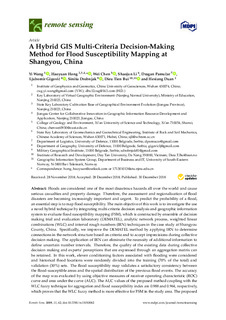| dc.contributor.author | Wang, Yi | |
| dc.contributor.author | Hong, Haoyuan | |
| dc.contributor.author | Chen, Wei | |
| dc.contributor.author | Li, Shaojun | |
| dc.contributor.author | Pamučar, Dragan | |
| dc.contributor.author | Gigović, Ljubomir | |
| dc.contributor.author | Drobnjak, Siniša | |
| dc.contributor.author | Tien Bui, Dieu | |
| dc.contributor.author | Duan, Hexiang | |
| dc.date.accessioned | 2019-11-05T09:56:52Z | |
| dc.date.available | 2019-11-05T09:56:52Z | |
| dc.date.created | 2019-01-07T11:29:19Z | |
| dc.date.issued | 2019 | |
| dc.identifier.citation | Remote Sensing. 2019, 11 (1), 1-31. | nb_NO |
| dc.identifier.issn | 2072-4292 | |
| dc.identifier.uri | http://hdl.handle.net/11250/2626552 | |
| dc.description | Licensee MDPI, Basel, Switzerland. This article is an open access article distributed under the terms and conditions of the Creative Commons Attribution (CC BY) license | nb_NO |
| dc.description.abstract | Soil salinity caused by climate change associated with rising sea level is considered as one of the most severe natural hazards that has a negative effect on agricultural activities in the coastal areas in most tropical climates. This issue has become more severe and increasingly occurred in the Mekong River Delta of Vietnam. The main objective of this work is to map soil salinity intrusion in Ben Tre province located on the Mekong River Delta of Vietnam using the Sentinel-1 Synthetic Aperture Radar (SAR) C-band data combined with five state-of-the-art machine learning models, Multilayer Perceptron Neural Networks (MLP-NN), Radial Basis Function Neural Networks (RBF-NN), Gaussian Processes (GP), Support Vector Regression (SVR), and Random Forests (RF). For this purpose, 63 soil samples were collected during the field survey conducted from 4–6 April 2018 corresponding to the Sentinel-1 SAR imagery. The performance of the five models was assessed and compared using the root-mean-square error (RMSE), the mean absolute error (MAE), and the correlation coefficient (r). The results revealed that the GP model yielded the highest prediction performance (RMSE = 2.885, MAE = 1.897, and r = 0.808) and outperformed the other machine learning models. We conclude that the advanced machine learning models can be used for mapping soil salinity in the Delta areas; thus, providing a useful tool for assisting farmers and the policy maker in choosing better crop types in the context of climate change. View Full-Text | nb_NO |
| dc.language.iso | eng | nb_NO |
| dc.rights | Navngivelse 4.0 Internasjonal | * |
| dc.rights.uri | http://creativecommons.org/licenses/by/4.0/deed.no | * |
| dc.title | A Hybrid GIS Multi-Criteria Decision-Making Method for Flood Susceptibility Mapping at Shangyou, China | nb_NO |
| dc.type | Journal article | nb_NO |
| dc.type | Peer reviewed | nb_NO |
| dc.description.version | publishedVersion | nb_NO |
| dc.rights.holder | © 2018 by the authors. | nb_NO |
| dc.source.pagenumber | 1-31 | nb_NO |
| dc.source.volume | 11 | nb_NO |
| dc.source.journal | Remote Sensing | nb_NO |
| dc.source.issue | 1 | nb_NO |
| dc.identifier.doi | 10.3390/rs11010062 | |
| dc.identifier.cristin | 1651369 | |
| cristin.unitcode | 222,57,1,0 | |
| cristin.unitname | Institutt for økonomi og IT | |
| cristin.ispublished | true | |
| cristin.fulltext | original | |
| cristin.qualitycode | 1 | |

